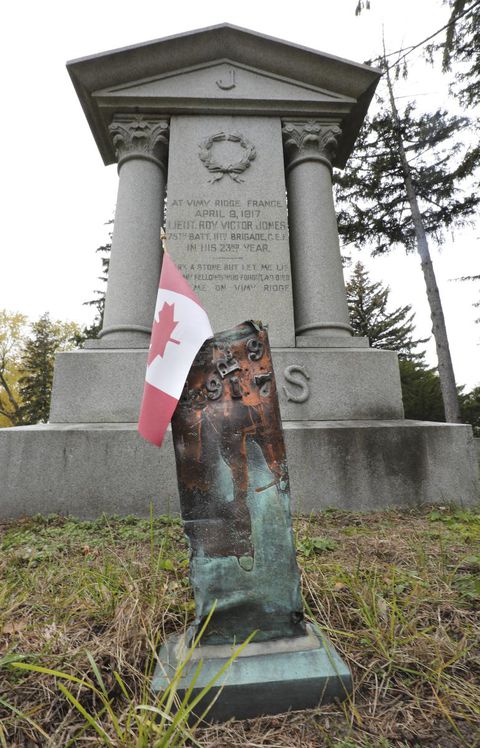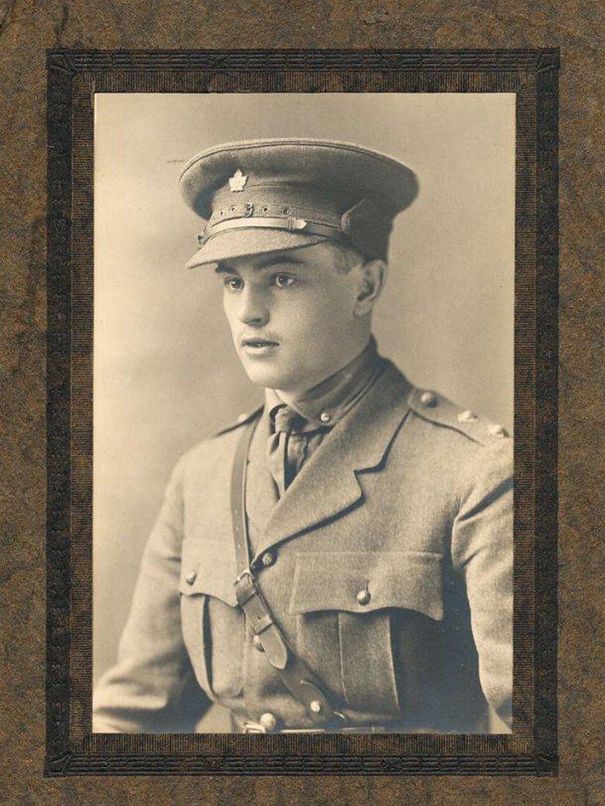At Park Lawn Cemetery in Etobicoke there is a deformed bronze stump where a cross once stood. It looks like a gnarled finger flayed at the tip. Although it is no longer complete, it still points to the skies, to the soldier it was meant to commemorate.
His name was Lieutenant. Roy Victor Jones of the 75th Battalion, and was instantly killed by a German machine gunner while leading his platoon at the Battle of Vimy Ridge in 1917. Jones, the middle son in a wealthy Toronto family, left the city to fight in the Great War at age 19. Three years later he was dead.
Fifty years after that, a priceless relic and symbol of Jones’ sacrifice was looted from his monument. Where he is today is a mystery, one that has haunted the Jones family for half a century.
When Jones was buried in France, he and others who died had their graves marked with wooden crosses with diamond-shaped edges. After the war, many of those fragile crosses were burned and replaced with stone markers.
But not from Jones.
“When you go to Flanders Fields, you expect to see crosses,” he said. historical blogger Martha Jackson. “John McCrae wrote ‘Between the crosses, row after row.’ But they are not there. They were offered to parents and widows if they wanted to be sent home. Most did not, but the Jones family did. It would have been a real treasure.
“I was horrified when I found out what happened to him.”
The Jones family paid handsomely (one descendant estimated thousands of dollars today) for the four-foot cross to be shipped to Canada, copper-plated and engraved. It was placed in front of the lieutenant’s cenotaph at Etobicoke sometime in the late 1930s.
You won’t find it there today.
In 1970, with the help of a chainsaw, the cross was stolen and was never seen again. A police report was filed, though Toronto police this week couldn’t find a record of it, and the man who did it has since died.
“It has bothered me for years and years and years,” said Thomas McCue, Jones’ distant maternal cousin. “Right now, I don’t feel like it belongs to anyone in particular. It belongs to a museum. I think it has to be found and placed somewhere not only for the family, but so that everyone can see it and know the story. “
McCue and his family always dreamed of retrieving the cross. To that end, McCue ducked into rabbit holes investigating war memorabilia deals on the black market. The cross must be in a private collection somewhere, he thought. It had to have been taken for a reason.
“There is a whole series of people who trade clandestinely with illegal militaria,” he said. “It is so strange to me. I discovered it while looking for the cross. The person who stole it would have known its value, it is essentially priceless. ”
McCue and his family’s theory that the cross exists on display somewhere is reinforced by the fact that copper was relatively inexpensive at the time of the theft, much of the metal was left behind, and heavy equipment would have been necessary. to steal it, indicating premeditation. But in 50 years of searching, it never appeared.
“We’d be so relieved to get it back, it would feel like a mystery has been solved,” McCue said. “I don’t think anyone has a real idea of what happened. I think my idea of it being in the hands of a collector is correct, but I don’t have any proof, it’s just guesswork on my part. ”
For McCue, the personal meaning of the cross is second only to its historical importance: such an artifact should not be in a basement somewhere, he said, it should be seen and remembered by everyone, lest we forget it.
But it was still a treasured family heirloom, the source of a phantom pain McCue has felt all his life. Relief only comes in moments of connection with Jones, talking about him in the high schools McCue teaches, leaving notes for the lieutenant at his grave in France, paying respects to the broken cross. With the monument in ruins, McCue has to work to keep Jones’s memory alive.
“I don’t want them to forget it,” he said. “There are some soldiers’ graves where you can say that no one has ever been. You just can’t forget these people. They cannot be forgotten. “
In the professional opinion of Dave Hiorth, owner of Military Antiques Toronto, the cross no longer exists.
“It was probably sold for the value of copper, really,” he said. “As bad as it may sound, you are not talking about the 13th battalion or the 10th battalion, where everyone goes crazy for them. Unfortunately, the 75 is not one of the best known units. It is still a good thing, but it does not have the same value. There are fewer collectors for it. But if this was the thirteenth battalion, I could definitely sell it to some crazy guy in Montreal. “
Tim Stewart, an avid militaria collector, historian, and curator of the Toronto Scottish Regiment Museum, which handles material from the 75th battalion, said that if the cross had been sold, he probably would have known.
“Dave (Hiorth) and I have been collecting for 40 years and I’ve never heard of anything like this come up,” he said. “It was taken before my time, but the collection field is small in Canada, and I’m sure the story would have been told by now.”
Stewart’s theory is abject hooliganism.
“It is possible that someone could have it in their collection, but I think they are more vandals than anything,” he said. “50 years ago, I don’t think there was a huge demand for scrap.”
Stewart couldn’t help but retrieve the cross, but he has done more than almost anyone to perpetuate Jones’ memory. He wrote the book in the 75th Battalion, which includes a brief biography of the lieutenant himself.
Whether or not Jones’ cross is hanging somewhere, destined to be returned, or living a reinforced second life, it is not what is needed to keep Jones in the collective consciousness of Canada. Their history cannot be cut down with a saw, it lives on in minds and hearts thanks to the dedication of historians and their ancestors.
Reference-www.thestar.com


